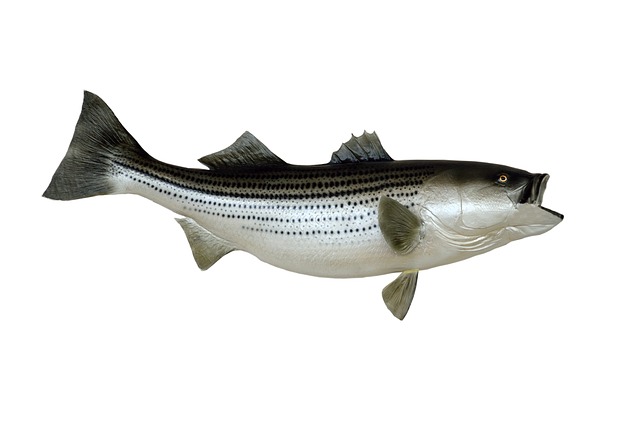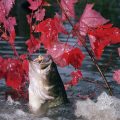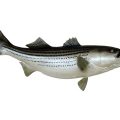
Description
Striped
Bass, otherwise called Rockfish is a standout among the most perceived fish in
Narragansett Narrows. It has a thick, stout body with around seven to eight
limited even stripes. It has two blades; one has got spines while the other one
is only delicate without any spines. It has a generally wide tail, expansive
mouth with little teeth. The lower jaw of striped bass juts somewhat more than
the upper jaw.
Life history and Habitat
Striped bass
does not travel so far until they are 2 years old. This fish was originally
produced in the Chesapeake Bay in 1934 and 1942 appeared in New England two
years later. It appeared in the Gulf of Maine as well in 1936 and 1944. This
shows that this fish has the capability of traveling far when they reach their
third year. Striped bass are known to live in the ocean, but they move to
brackish water to reproduce.
The males
mature between the age of two and four while females mature between ages four
and eight. The females produce eggs in large quantities which are then
fertilized by the males. The fertilized eggs flow with the currents downstream
then they hatch into larvae. During the downstream journey, the larvae and
post-larvae feed on small animals. After reaching the inland portions of
coastal sounds and the river deltas mainly where their nurseries are, the
larvae mature into Juveniles.
Striped bass
reproduce between the months of April and June as they move to fresh water. The
adult stripers spend most of their lives in the ocean or the coastal estuaries.
Research has shown female Stripers’ age of sexual maturity is between the age
of four and eight. Managers used this information to set the biomass threshold
basing it on the amount of female striped bass that has reached the sexual
maturity age in the population. Striped bass can live for about 30 years.
Migration
Striped bass
move north and south seasonally and ascends to rivers to procreate in the
spring. Male Stripers may sometimes refrain from migrating to the coastal
regions and remain in the Bay.
General range
Atlantic
coast- the rockfish ranges from St. Lawrence River in Canada and St. John’s
River in Florida. Rockfish have been introduced successfully to the Pacific
coast where the range goes from Grays Harbor wash to Los Angeles. Striped bass
were also introduced to the inland lakes and reservoirs.
Feeding
Striped bass
feed on different types of food during their life cycle. They eat fish larvae,
worms, zooplankton, amphipods, insects, herring, spot, Bay anchovy, shad,
menhaden, yellow perch, and white perch. The variety of food they eat explains
their importance in Chesapeake’s food web.
Growth rate
Striped bass
growth rate varies depending on a number of reasons. A combination of season,
sex, age competition, and location determine their growth rate. Their growth is
faster before they reach the age of sexual maturity that is during the second
and third year of their life. Growth slows down when they approach the last
years of their lives. From age 4 to 8, the growth rate is at 2.5 to 3 inches
per year. Starting at age 4, female striped bass grow faster than males.
Stripers experience maximum growth during the months of April and October.
Size
In 1891, the
largest striped bass that weighed 125 pounds kept a record. It was a female
stripper that was caught off in North Carolina. In Chesapeake’s Bay, the
largest stripper weighs 68 pounds and below. In general, striped bass grows up
to 59 inches long and 55 to 77 pounds in weight.
Reproduction
Striped bass
are known to live in the ocean but they move to fresh water to reproduce. Their
males mature between the age of two and four while females mature between ages
four and eight. The females produce eggs in large quantities which are then
fertilized by the males. The fertilized eggs flow with the currents downstream
then they hatch into larvae.
During the downstream journey, the larvae and
post-larvae feed on small animals. After reaching the inland portions of
coastal sounds and the river deltas mainly where their nurseries are, the
larvae mature into Juveniles. Striped bass reproduces between the month of
April and June as they move to fresh water.
Predators
Bluefish,
Silver hake, Cod and weakfish are the major predators of small striped bass
(Juvenile). Apart from sharks and seals, big striped bass have few predators.
Striped bass are important predators in marine and coastal ecosystems.
Occurrence in the Gulf of Maine
Striped bass
occur at the coastline of Gulf from Cape Cod to Western Nova. Their occurrence
depends on a number of factors one being whether it is a good bass year or a
bad one. The outer shore of Cape Cod offers the most productive surf casting.
At the point
when bass are sensibly abundant, as they have been the previous 15 years, and
with a decent portrayal of fish of various ages, the external shore of Cape Cod
gives the most gainful surf throwing, with Monomoy Island. The general region
of Nauset Bay, and the tip of the Cape northward from Good country Light maybe
the hottest stretches, in many years. Yet, the geology of shoreline might be
adjusted to such a degree amid extreme tempests that a stretch that is great
bass water one summer, might be poor the following.
Nauset
shoreline is a precedent, for not very many bass have been gotten or seen there
in the summer. However, this has been a standout among the most beneficial
regions on the Cape among previous couple of summers. Extensive numbers of the
littler sizes are in the Charming Inlet as well as inside Nauset Swamp, and
around the local area Bay Orleans.











Pingback: KastKing Crixus Fishing Rod Review | Reel Fishing Guru